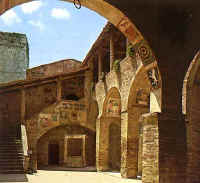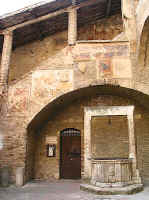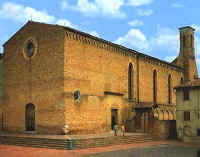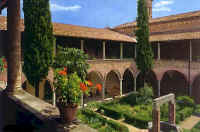Main sights of San Gimignano
The Duomo or Collegiate Church
of San Gimignano (Santa Maria Assunta), situated on the
west side of the Piazza del Duomo, is a
fairly rare example of Tuscan Romanesque architecture on the grand
scale. The altars, chapels, friezes, frescoes and paintings with which
it was filled were commissioned from the most famous artists of the day by the persons responsible for the Opera del
Duomo, by public administrators and
by private citizens. The church was originally a simple parish church that was transformed in 1056 into a
Propositura
(a parish church responsible for other smaller parish churches in the surrounding area) by Pope
Victor II. In 1148, it was consecrated by Pope Eugenius III as he
returned to Rome along the Via
Francigena, and, in 1182, a papal Bull issued by Pope Lucio III granted it numerous privileges. In 1220 Pope
Honorius III confirmed the Canonical Chapter’s privileges, and this
was repeated by Pope Innocent IV did in 1241.
|
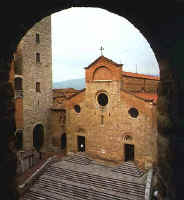
|
This extraordinary attention given to the church by important religious dignitaries led the
Proposto (the person responsible for the Propositura), Canons, and the municipality to make the church a more
magnificent place of worship worthy of its reputation. It became a Basilica in
1232. In 1238, work to enlarge and embellish the church began
and continued until the end of the 17 C. The Saints of San
Gimignano such as St. Fina, St. Bartolo, St. Piero The Martyr and the Blessed
Ciardo, were worshipped and celebrated in the church. Gimignano, the Saint and Bishop of
Modena, has his remains and his altar here. Every year on 31 January (St. Gimignano Day) he is the object of special celebration. Canons,
and Franciscan, Capuchin, Dominican and Augustinian friars preached from the pulpit of the church. Girolamo Savonarola
preached in the Duomo in 1483. Several Cardinals were given the title of
Proposto of the church,
including Giordano Orsini (1146), Napoleone Orsini (1314), Francesco Carbone
(1389), Francesco Soderini (1495) and Baldassarre Cossa who was elected Antipope in 1410 and removed in 1414 by the Council of
Costanza. |
Inside the Duomo, there are many very beautiful frescoes. Along the walls in the left aisle, Bartolo di Fredi painted "Scenes from the Old Testament" and in the right aisle
there are frescoes representing "Scenes from the New Testament", originally considered to be the work of Barna da Siena and recently attributed to
the workshop of the Memmi.
In the central nave, there are two famous wooden statues by Jacopo della Quercia standing on
either side of the fresco by Benozzo Gozzoli illustrating the Martyrdom of St. Sebastiano. On the upper part of the central nave between the two doors, above the first two arches on the right and left hand sides, are Taddeo di Bartolo’s frescoes
of the Last Judgement. In the right aisle, next to the transept, is the famous Chapel of St. Fina built in 1468. It is the most precious work of art in the Duomo
due to its elegant altar by Benedetto da Maiano and to its frescoes by Domenico Ghirlandaio representing on the right hand side "St. Gregorio foretelling St. Fina of her approaching death" and on the left hand side
her "Funeral Rites".
|
The Palazzo del Podestà, San Gimignano
|
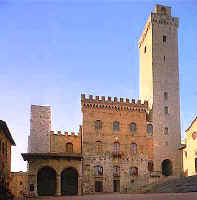
|
The People’s Palace or
New Podesta’s Palace, which is today the home of the Town Council is situated on the left hand side of the Duomo square. It is one of the most important monuments of San
Gimignano, being both the home of the Civic Museum and rich in paintings by the Florentine and Sienese schools (dating from the
13 C) such as the Crucifix, painted by Coppo di Marcovaldo, the triptyches by Niccolò Tegliacci and Taddeo di Bartolo dating from the
14 C, and other important works of art dating from the 15 C painted by Domenico
Michelino, Pinturicchio and Filippino Lippi. In the different rooms of the Palace
there a fine frescoed walls including the "Scenes of private life" painted by Memmo di Filippuccio and "The
Maestà" painted by Lippo Memmi. |
On the right hand side of the Palace rises the high "Great Tower" erected in 1300. On the balcony above the entrance, the
Podestà (person responsible for the Municipality) took his oath. In front of the Palace and the Tower,
is a ballatoio (stairs leading to and from a narrow terrace) called
l’Arengo.
Church of St. Agostino, San Gimignano
The
church can be reached from the Porta St. Matteo by passing along via
Cellolese. Its very simple façade still retains the characteristics of its original architectural style. The door in the main façade is not used as the
entrance. Instead, the door on the right hand side is generally used to
enter the church. The interior of the Church consists of a single large nave with three ogival apses.
The roof is supported by a wooden framework. The construction of the Church of St.
Agostino, with a single nave in Romanesque style with Gothic elements, began in 1280 and terminated on 31st March 1298 when it was consecrated by Cardinal Matteo D’Acquasparta.
The Prior Fra Domenico Strambi was responsible for the building of the
cloister in the second half of the 15 C and the decoration of the Church in Renaissance style.
The Chapel of the Blessed Bartolo, whose mortal remains are kept in a marble monument sculpted by Benedetto da Maiano in
1495, is extremely interesting. In 1500 Sebastiano Mainardi frescoed the
chapel’s walls and vaults. Its terracotta floor is the work of Andrea della
Robbia. The Coronation of the Madonna and the Saints, painted in 1483 by Piero del
Pollaiolo, is located above the high alter. The frescoes in the chancel representing
Episodes from the life of St. Agostino were painted by Benozzo Gozzoli between 1464 and 1465 with the help of two of his pupils, Pier Francesco Fiorentino and Giusto d’Andrea who also painted the votive fresco of St.
Sebastiano.
Other notable works of art in this church are the fragments remaining from a fresco by Bartolo di Fredi and a fresco showing
the Madonna painted by Lippo Memmi in 1317, as well as the tablet representing
The Madonna and the Saints painted by Fra Bartolomeo in 1530 and, in the sacristy, a wooden Crucifix dating from the 15th century.
|
|


